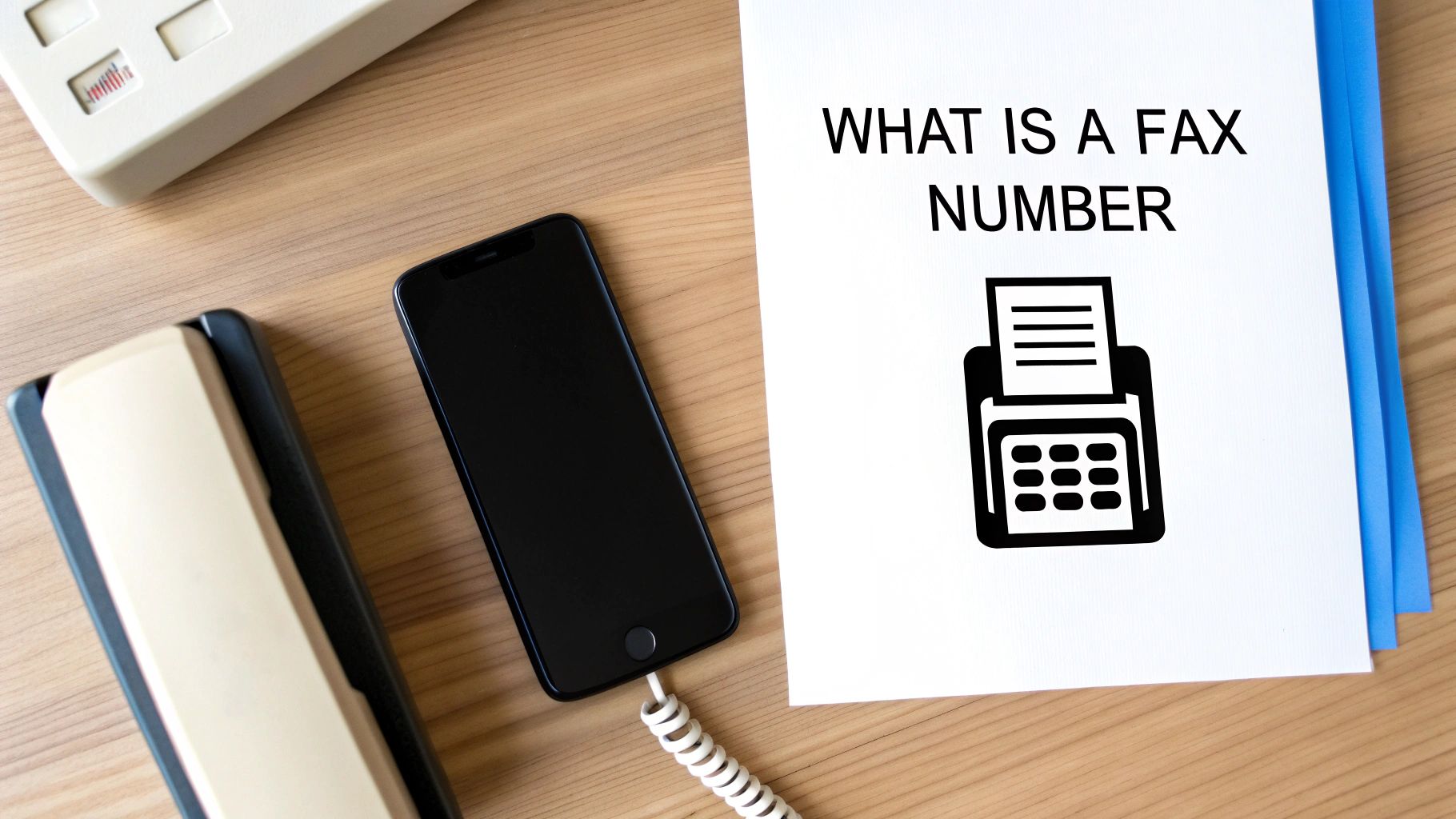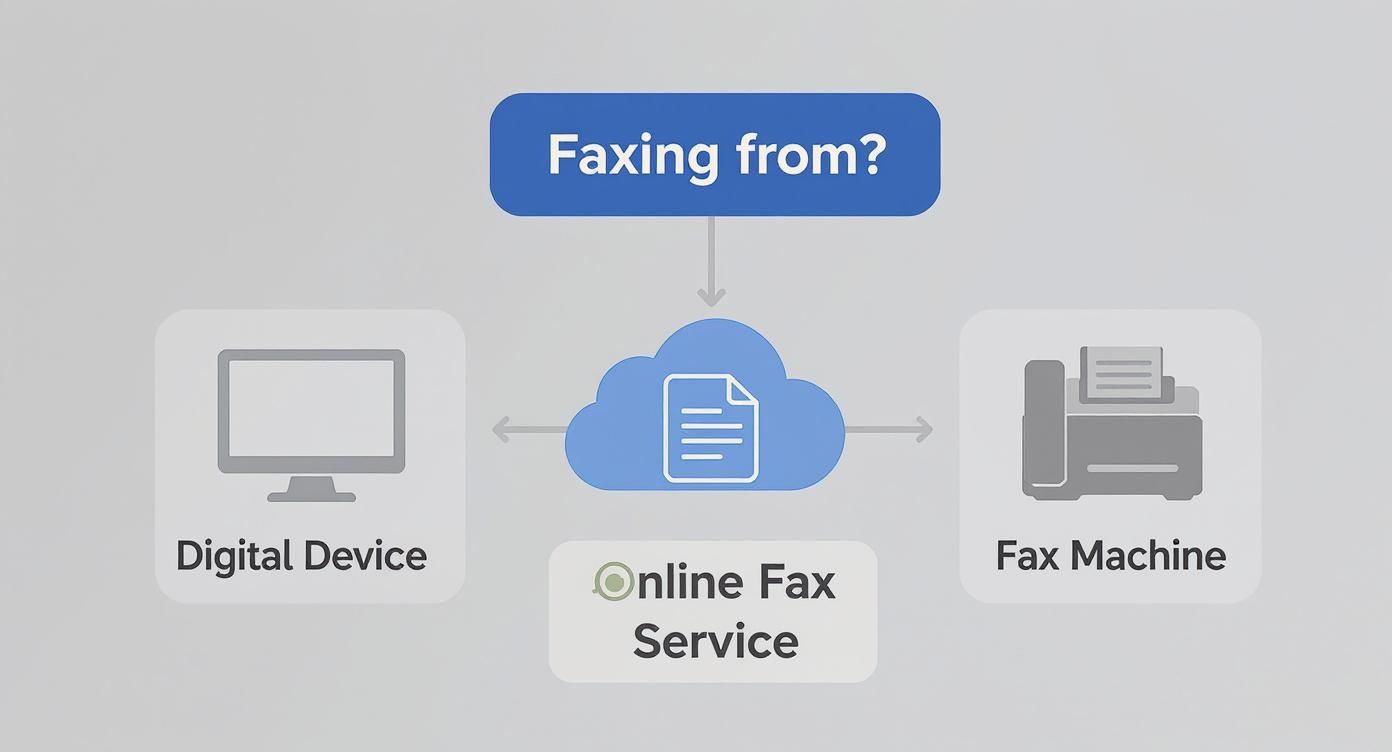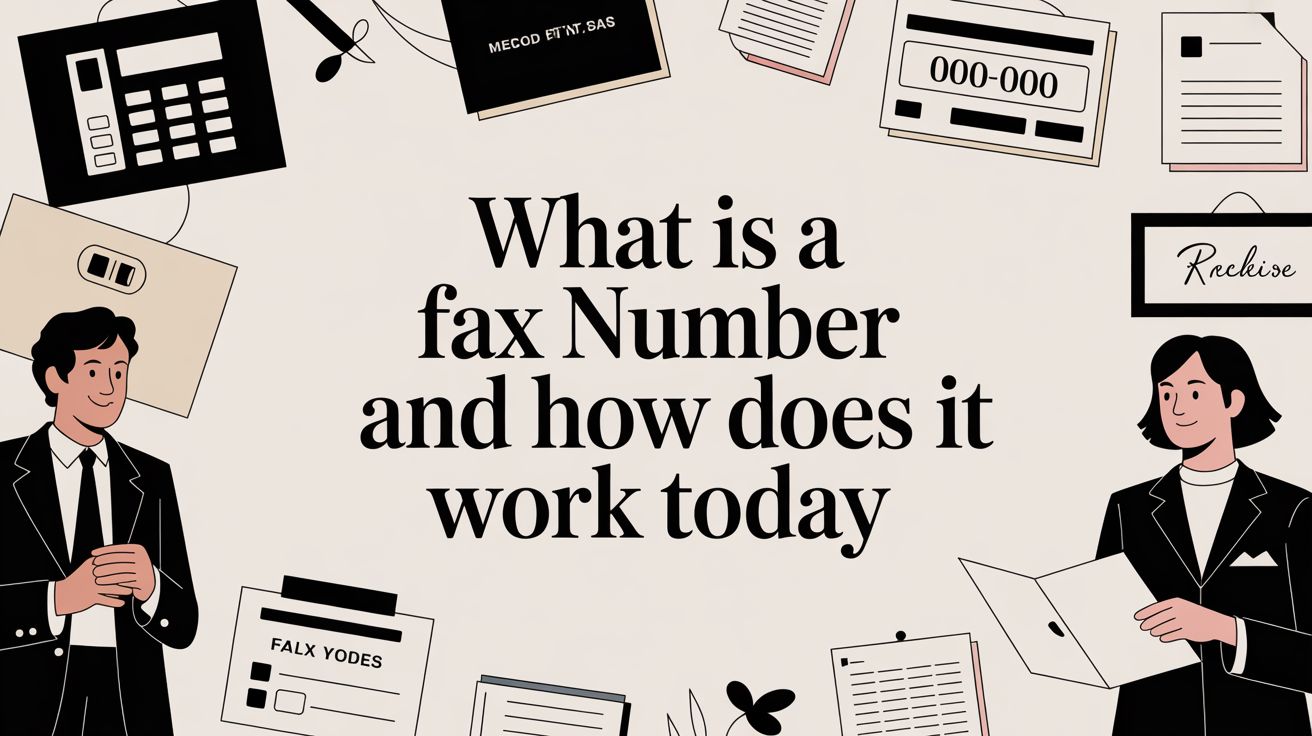At its most basic, a fax number is a dedicated phone number for a fax machine or, more commonly these days, an online fax service. Think of it like a direct, secure mailing address for your documents. It's this unique identifier that ensures your sensitive files land in exactly the right hands, which is a big reason why faxing remains a trusted communication method in many industries.
This dedicated line is what sets faxing apart from email. It creates a point-to-point connection for transmitting information, providing a level of security and legal standing that a standard email just can't match.
What Exactly Does a Fax Number Do?

While a fax number looks and dials just like a regular phone number, it connects to a completely different kind of endpoint. If you were to accidentally call one from your cell phone, you wouldn't hear a person's voice. Instead, you'd be greeted by the high-pitched squeal of a fax machine's "handshake"—the sound of two devices establishing a secure connection to exchange documents.
This distinction is key. An email address can be faked or intercepted relatively easily, but a fax number is tied to a specific line, whether physical or virtual. This adds a powerful layer of authenticity and reliability to the process, a feature that has kept faxing relevant for nearly two centuries. You can dive deeper into the fascinating history of the fax machine to see just how far the technology has come.
From Old-School Phone Lines to the Cloud
The fax number itself has evolved right alongside the technology. It’s no longer just about clunky machines plugged into a wall. Today, virtual fax numbers are the standard, operating completely online and untethered from any physical hardware.
This means you can send and receive faxes directly through the tools you already use every day:
- Your email inbox (like Gmail or Outlook)
- A simple web portal on your computer
- A mobile app on your smartphone
This modern approach gives you the best of both worlds. You get the robust security and legal weight of a traditional fax transmission, but with all the convenience and flexibility of a digital workflow. It’s a dedicated, private line for your documents, without the dedicated machine.
How Modern Fax Numbers Connect the Digital and Physical Worlds
So, how exactly does a fax number work today without a bulky machine plugged into a phone jack? The magic is in something called a virtual fax number. It’s the key that connects the internet to the old-school telephone network, letting you send and receive faxes right from your email, a website, or an app on your phone.
Think of an online fax service as a universal translator for your documents. When you hit "send" on a PDF from your computer, the service takes that digital file and converts it into the classic fax signal that traditional machines recognize. It then dials the recipient's fax number and delivers it just like any other fax.
The process works just as smoothly in reverse. When someone sends a fax from a physical machine to your virtual fax number, the service catches that analog signal. It then translates it back into a digital file (usually a PDF) and drops it neatly into your email inbox.
The Freedom of a Virtual Number
This seamless translation is what makes modern faxing so incredibly useful. It unties the fax number from a physical location and a specific machine, giving you the freedom to handle faxes from anywhere.
The core benefits are pretty clear:
- Work From Anywhere: You can send or receive faxes from your laptop during a business trip or from your phone while grabbing coffee. Your fax number follows you.
- No More Hardware: Forget about paper jams, empty toner cartridges, or that dreaded busy signal. Your computer or smartphone is all you need.
- Simple Integration: Faxes land in your inbox as email attachments, so you can save, forward, and organize them just like any other digital file. Our guide on how to send a fax online walks you through how easy it is.
Even with this shift to internet faxing, the fax number itself remains just as important. It’s still that unique, trusted identifier. In fact, around 90% of businesses looking at online fax solutions want to keep their existing numbers to avoid disrupting their operations.
This dedication to the number comes from its long-standing role as a reliable address that helps give documents legal weight. You can explore more data on the internet fax market to see just how strong this trend is. This digital-to-analog bridge is what guarantees your documents get where they need to go, whether the person on the other end has a brand-new online service or a fax machine from the 90s.
Choosing the Right Type of Fax Number
Picking the right fax number is a lot like choosing a phone number for your business. It's more than just a string of digits; it communicates something about your company before a single page is sent. Your choice really boils down to what kind of message you want to send.
Most businesses start with a local fax number. This ties you to a specific geographic area with a familiar area code, like (212) for New York City or (213) for Los Angeles. It’s a great way to build trust and show you’re part of the local community, making customers feel like you're right around the corner.
Local vs. Toll-Free: What's the Best Fit?
But what if your business serves clients all over the country? That's where a toll-free fax number comes in. Using prefixes like 800, 888, or 877, these numbers signal that you're a national player. Plus, they make it completely free for anyone, anywhere, to send you a fax, which is a fantastic customer-friendly touch.
For businesses looking to make a memorable impression, there's also the vanity fax number. Think of something catchy like 1-888-TAX-FIRM. It's far easier for a client to remember than a random set of numbers and acts as a mini-advertisement every time it's used.
This table breaks down the key differences to help you decide which number is right for your business.
Comparing Local vs Toll-Free Fax Numbers
| Feature | Local Fax Number | Toll-Free Fax Number |
|---|---|---|
| Geographic Reach | Tied to a specific city or region | Nationwide; not tied to a location |
| Cost to Sender | Sender pays standard long-distance fees | Free for the sender to use |
| Best For | Businesses serving a local community | National companies, customer service |
| Brand Perception | Approachable, community-focused | Professional, established, national |
| Example | (212) 555-0123 for a NYC-based firm | 1-888-555-0123 for a national retailer |
Ultimately, a toll-free number removes any cost barrier for your contacts, making it dead simple for them to do business with you. It’s a small detail that can really elevate your brand's image from a local shop to a national enterprise.
No matter which type you pick, the good news is that modern faxing has moved online. Whether you're sending from a computer or an old-school fax machine, the transmission is now handled by a cloud-based service.

As you can see, all roads lead to the cloud. This modern approach means you can easily fax without a fax machine, right from your laptop or smartphone, giving you incredible flexibility.
Why Fax Numbers Still Matter for Security
With email and instant messaging at our fingertips, you might wonder why fax numbers are still a thing. The answer boils down to one critical word: security. When you send a fax, you're creating a direct, point-to-point connection over the phone network. This is a fundamentally more secure channel than sending an email across the wide-open internet.
Think of it this way: an email is like a postcard that passes through many hands and can be easily read along the way. A fax, on the other hand, is like a sealed letter delivered by a private courier straight to the recipient. This direct line makes it incredibly tough for anyone to intercept the information while it's in transit, which is a major reason it's stuck around.
This built-in security is precisely why faxing remains the go-to method for sending sensitive documents in industries with strict regulations.
The Foundation of Compliance and Legal Weight
In fields like healthcare, law, and finance, following the rules isn't optional—it's the law. Regulations like the Health Insurance Portability and Accountability Act (HIPAA) require ironclad protection for patient information. Faxing helps organizations tick those boxes by offering a secure and traceable way to move documents.
When you send a fax, the machine generates a confirmation page—a receipt showing the date, time, and the exact number it was sent to. This little piece of paper is a powerful tool, often serving as legal proof of delivery in court or for official records.
Trying to get that same level of proof with email is tricky. "Read receipts" are unreliable and can be easily faked or ignored. The fax number, however, is a fixed, trusted endpoint that creates a clear and undeniable audit trail.
The numbers back this up, too. The global fax services market was valued at USD 3.31 billion this year and is expected to keep growing. That growth is fueled by the very industries that can't afford to compromise on secure, compliant document exchange. For a deeper dive, check out this comprehensive fax services market report.
How to Get a Fax Number in Under 5 Minutes
https://www.youtube.com/embed/IVl71CHCg3s
Long gone are the days of calling up the phone company and waiting around for a technician to install a dedicated line. You can now get a fully functional virtual fax number in less time than it takes to brew a pot of coffee. The whole thing happens online, giving you a secure line for your documents right away.
The first move is picking an online fax service. You'll want to find one that offers a painless setup, transparent pricing, and the kind of numbers you need—whether that's a local number for a community feel or a toll-free one for a more professional image. Services like SendItFax are built to get you started without a bunch of complicated hoops to jump through.
Choosing Your Number and Plan
Once you've landed on a provider, getting your number is usually a quick, three-step dance:
- Select Your Plan: Most services have a few different options based on your expected fax volume—how many pages you think you'll send or receive each month.
- Pick Your Number: This is the fun part. You can grab a brand new local or toll-free number from their inventory.
- Provide Basic Info: Just plug in your email address (this is where your faxes will arrive) and a payment method if you're signing up for a paid plan.
And that's it—you're done. Your new fax number is live and ready for action, accessible straight from your email or the service's online dashboard. With your new number in hand, you can even send a fax online for free.
Pro Tip: Have an old fax number your clients already know? Don't sweat it. Most online providers let you "port" your existing number over to their service. It's a fantastic way to upgrade your tech without forcing everyone to update their contact lists.
Fax Number FAQs
Even though we've moved most things online, fax numbers still raise a few practical questions. Let's clear up some of the most common ones so you can handle modern faxing like a pro.
A lot of people wonder if a fax number is the same as a regular phone number. They certainly look the same and even use the same phone network, but a fax number is set up specifically to talk to a fax machine or an online fax service.
Ever tried calling a fax line from your phone by mistake? You won't get a person on the other end. Instead, you'll be greeted by that high-pitched screeching sound—that's the fax machine trying to connect. While some fancy systems can handle both voice and fax calls on one line, most businesses keep them separate to make sure a fax never gets missed.
Can I Use My Email to Send Something to a Fax Number?
You bet. This is one of the best parts about modern online faxing. You can send a fax right from your email account, blending the old-school security of a fax with the convenience you're used to.
It's surprisingly straightforward. You just open a new email, attach the document you want to send (like a PDF or Word file), and type in a special address. It usually looks something like this: [faxnumber]@yourfaxservice.com.
Think of the fax service as a clever translator. It takes your email and its attachment, converts them into the language a fax machine understands, and then dials the recipient's number. Once it's delivered, you get a confirmation receipt right back in your inbox, giving you a clear, verifiable paper trail.
Do I Still Need a Landline for a Fax Number?
Nope, not anymore. A dedicated landline is a thing of the past for faxing. The virtual fax numbers you get from online services work completely over the internet, so you're not tied to any physical machines or extra phone lines.
This means you can send and receive faxes from anywhere, using your computer, tablet, or smartphone. All you need is your email or the service's app, giving you total freedom to work from wherever you happen to be.
